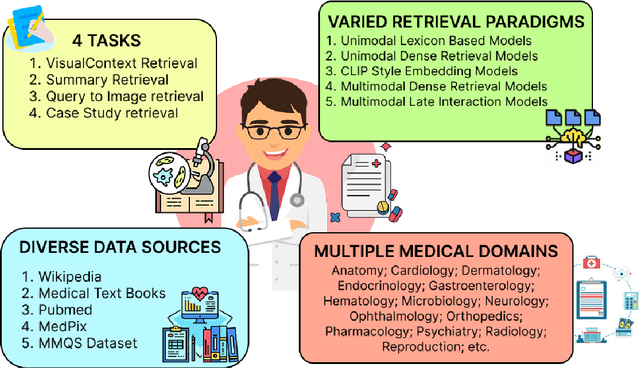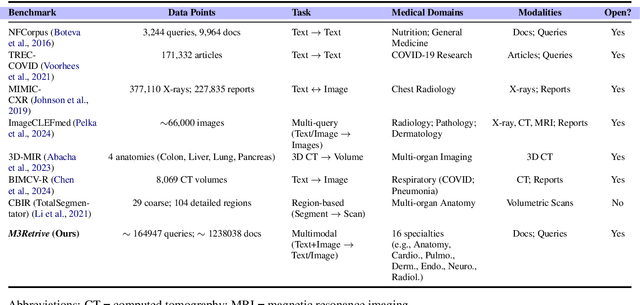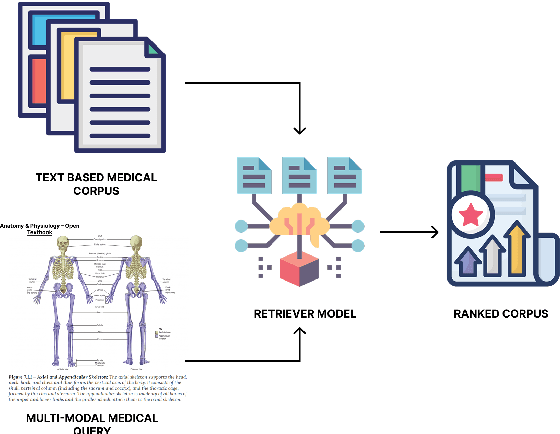Medical Image Retrieval
Medical image retrieval is the process of searching for and retrieving medical images based on content similarity or relevance.
Papers and Code
Acquisition of interpretable domain information during brain MR image harmonization for content-based image retrieval
Oct 16, 2025Medical images like MR scans often show domain shifts across imaging sites due to scanner and protocol differences, which degrade machine learning performance in tasks such as disease classification. Domain harmonization is thus a critical research focus. Recent approaches encode brain images $\boldsymbol{x}$ into a low-dimensional latent space $\boldsymbol{z}$, then disentangle it into $\boldsymbol{z_u}$ (domain-invariant) and $\boldsymbol{z_d}$ (domain-specific), achieving strong results. However, these methods often lack interpretability$-$an essential requirement in medical applications$-$leaving practical issues unresolved. We propose Pseudo-Linear-Style Encoder Adversarial Domain Adaptation (PL-SE-ADA), a general framework for domain harmonization and interpretable representation learning that preserves disease-relevant information in brain MR images. PL-SE-ADA includes two encoders $f_E$ and $f_{SE}$ to extract $\boldsymbol{z_u}$ and $\boldsymbol{z_d}$, a decoder to reconstruct the image $f_D$, and a domain predictor $g_D$. Beyond adversarial training between the encoder and domain predictor, the model learns to reconstruct the input image $\boldsymbol{x}$ by summing reconstructions from $\boldsymbol{z_u}$ and $\boldsymbol{z_d}$, ensuring both harmonization and informativeness. Compared to prior methods, PL-SE-ADA achieves equal or better performance in image reconstruction, disease classification, and domain recognition. It also enables visualization of both domain-independent brain features and domain-specific components, offering high interpretability across the entire framework.
S-Chain: Structured Visual Chain-of-Thought For Medicine
Oct 26, 2025Faithful reasoning in medical vision-language models (VLMs) requires not only accurate predictions but also transparent alignment between textual rationales and visual evidence. While Chain-of-Thought (CoT) prompting has shown promise in medical visual question answering (VQA), no large-scale expert-level dataset has captured stepwise reasoning with precise visual grounding. We introduce S-Chain, the first large-scale dataset of 12,000 expert-annotated medical images with bounding boxes and structured visual CoT (SV-CoT), explicitly linking visual regions to reasoning steps. The dataset further supports 16 languages, totaling over 700k VQA pairs for broad multilingual applicability. Using S-Chain, we benchmark state-of-the-art medical VLMs (ExGra-Med, LLaVA-Med) and general-purpose VLMs (Qwen2.5-VL, InternVL2.5), showing that SV-CoT supervision significantly improves interpretability, grounding fidelity, and robustness. Beyond benchmarking, we study its synergy with retrieval-augmented generation, revealing how domain knowledge and visual grounding interact during autoregressive reasoning. Finally, we propose a new mechanism that strengthens the alignment between visual evidence and reasoning, improving both reliability and efficiency. S-Chain establishes a new benchmark for grounded medical reasoning and paves the way toward more trustworthy and explainable medical VLMs.
CLIN-LLM: A Safety-Constrained Hybrid Framework for Clinical Diagnosis and Treatment Generation
Oct 26, 2025Accurate symptom-to-disease classification and clinically grounded treatment recommendations remain challenging, particularly in heterogeneous patient settings with high diagnostic risk. Existing large language model (LLM)-based systems often lack medical grounding and fail to quantify uncertainty, resulting in unsafe outputs. We propose CLIN-LLM, a safety-constrained hybrid pipeline that integrates multimodal patient encoding, uncertainty-calibrated disease classification, and retrieval-augmented treatment generation. The framework fine-tunes BioBERT on 1,200 clinical cases from the Symptom2Disease dataset and incorporates Focal Loss with Monte Carlo Dropout to enable confidence-aware predictions from free-text symptoms and structured vitals. Low-certainty cases (18%) are automatically flagged for expert review, ensuring human oversight. For treatment generation, CLIN-LLM employs Biomedical Sentence-BERT to retrieve top-k relevant dialogues from the 260,000-sample MedDialog corpus. The retrieved evidence and patient context are fed into a fine-tuned FLAN-T5 model for personalized treatment generation, followed by post-processing with RxNorm for antibiotic stewardship and drug-drug interaction (DDI) screening. CLIN-LLM achieves 98% accuracy and F1 score, outperforming ClinicalBERT by 7.1% (p < 0.001), with 78% top-5 retrieval precision and a clinician-rated validity of 4.2 out of 5. Unsafe antibiotic suggestions are reduced by 67% compared to GPT-5. These results demonstrate CLIN-LLM's robustness, interpretability, and clinical safety alignment. The proposed system provides a deployable, human-in-the-loop decision support framework for resource-limited healthcare environments. Future work includes integrating imaging and lab data, multilingual extensions, and clinical trial validation.
M3Retrieve: Benchmarking Multimodal Retrieval for Medicine
Oct 08, 2025



With the increasing use of RetrievalAugmented Generation (RAG), strong retrieval models have become more important than ever. In healthcare, multimodal retrieval models that combine information from both text and images offer major advantages for many downstream tasks such as question answering, cross-modal retrieval, and multimodal summarization, since medical data often includes both formats. However, there is currently no standard benchmark to evaluate how well these models perform in medical settings. To address this gap, we introduce M3Retrieve, a Multimodal Medical Retrieval Benchmark. M3Retrieve, spans 5 domains,16 medical fields, and 4 distinct tasks, with over 1.2 Million text documents and 164K multimodal queries, all collected under approved licenses. We evaluate leading multimodal retrieval models on this benchmark to explore the challenges specific to different medical specialities and to understand their impact on retrieval performance. By releasing M3Retrieve, we aim to enable systematic evaluation, foster model innovation, and accelerate research toward building more capable and reliable multimodal retrieval systems for medical applications. The dataset and the baselines code are available in this github page https://github.com/AkashGhosh/M3Retrieve.
CardioBench: Do Echocardiography Foundation Models Generalize Beyond the Lab?
Oct 01, 2025Foundation models (FMs) are reshaping medical imaging, yet their application in echocardiography remains limited. While several echocardiography-specific FMs have recently been introduced, no standardized benchmark exists to evaluate them. Echocardiography poses unique challenges, including noisy acquisitions, high frame redundancy, and limited public datasets. Most existing solutions evaluate on private data, restricting comparability. To address this, we introduce CardioBench, a comprehensive benchmark for echocardiography FMs. CardioBench unifies eight publicly available datasets into a standardized suite spanning four regression and five classification tasks, covering functional, structural, diagnostic, and view recognition endpoints. We evaluate several leading FM, including cardiac-specific, biomedical, and general-purpose encoders, under consistent zero-shot, probing, and alignment protocols. Our results highlight complementary strengths across model families: temporal modeling is critical for functional regression, retrieval provides robustness under distribution shift, and domain-specific text encoders capture physiologically meaningful axes. General-purpose encoders transfer strongly and often close the gap with probing, but struggle with fine-grained distinctions like view classification and subtle pathology recognition. By releasing preprocessing, splits, and public evaluation pipelines, CardioBench establishes a reproducible reference point and offers actionable insights to guide the design of future echocardiography foundation models.
Johnson-Lindenstrauss Lemma Guided Network for Efficient 3D Medical Segmentation
Sep 26, 2025Lightweight 3D medical image segmentation remains constrained by a fundamental "efficiency / robustness conflict", particularly when processing complex anatomical structures and heterogeneous modalities. In this paper, we study how to redesign the framework based on the characteristics of high-dimensional 3D images, and explore data synergy to overcome the fragile representation of lightweight methods. Our approach, VeloxSeg, begins with a deployable and extensible dual-stream CNN-Transformer architecture composed of Paired Window Attention (PWA) and Johnson-Lindenstrauss lemma-guided convolution (JLC). For each 3D image, we invoke a "glance-and-focus" principle, where PWA rapidly retrieves multi-scale information, and JLC ensures robust local feature extraction with minimal parameters, significantly enhancing the model's ability to operate with low computational budget. Followed by an extension of the dual-stream architecture that incorporates modal interaction into the multi-scale image-retrieval process, VeloxSeg efficiently models heterogeneous modalities. Finally, Spatially Decoupled Knowledge Transfer (SDKT) via Gram matrices injects the texture prior extracted by a self-supervised network into the segmentation network, yielding stronger representations than baselines at no extra inference cost. Experimental results on multimodal benchmarks show that VeloxSeg achieves a 26% Dice improvement, alongside increasing GPU throughput by 11x and CPU by 48x. Codes are available at https://github.com/JinPLu/VeloxSeg.
Toward Medical Deepfake Detection: A Comprehensive Dataset and Novel Method
Sep 19, 2025The rapid advancement of generative AI in medical imaging has introduced both significant opportunities and serious challenges, especially the risk that fake medical images could undermine healthcare systems. These synthetic images pose serious risks, such as diagnostic deception, financial fraud, and misinformation. However, research on medical forensics to counter these threats remains limited, and there is a critical lack of comprehensive datasets specifically tailored for this field. Additionally, existing media forensic methods, which are primarily designed for natural or facial images, are inadequate for capturing the distinct characteristics and subtle artifacts of AI-generated medical images. To tackle these challenges, we introduce \textbf{MedForensics}, a large-scale medical forensics dataset encompassing six medical modalities and twelve state-of-the-art medical generative models. We also propose \textbf{DSKI}, a novel \textbf{D}ual-\textbf{S}tage \textbf{K}nowledge \textbf{I}nfusing detector that constructs a vision-language feature space tailored for the detection of AI-generated medical images. DSKI comprises two core components: 1) a cross-domain fine-trace adapter (CDFA) for extracting subtle forgery clues from both spatial and noise domains during training, and 2) a medical forensic retrieval module (MFRM) that boosts detection accuracy through few-shot retrieval during testing. Experimental results demonstrate that DSKI significantly outperforms both existing methods and human experts, achieving superior accuracy across multiple medical modalities.
Exploring the Capabilities of LLM Encoders for Image-Text Retrieval in Chest X-rays
Sep 17, 2025Vision-language pretraining has advanced image-text alignment, yet progress in radiology remains constrained by the heterogeneity of clinical reports, including abbreviations, impression-only notes, and stylistic variability. Unlike general-domain settings where more data often leads to better performance, naively scaling to large collections of noisy reports can plateau or even degrade model learning. We ask whether large language model (LLM) encoders can provide robust clinical representations that transfer across diverse styles and better guide image-text alignment. We introduce LLM2VEC4CXR, a domain-adapted LLM encoder for chest X-ray reports, and LLM2CLIP4CXR, a dual-tower framework that couples this encoder with a vision backbone. LLM2VEC4CXR improves clinical text understanding over BERT-based baselines, handles abbreviations and style variation, and achieves strong clinical alignment on report-level metrics. LLM2CLIP4CXR leverages these embeddings to boost retrieval accuracy and clinically oriented scores, with stronger cross-dataset generalization than prior medical CLIP variants. Trained on 1.6M CXR studies from public and private sources with heterogeneous and noisy reports, our models demonstrate that robustness -- not scale alone -- is the key to effective multimodal learning. We release models to support further research in medical image-text representation learning.
More performant and scalable: Rethinking contrastive vision-language pre-training of radiology in the LLM era
Sep 16, 2025The emergence of Large Language Models (LLMs) presents unprecedented opportunities to revolutionize medical contrastive vision-language pre-training. In this paper, we show how LLMs can facilitate large-scale supervised pre-training, thereby advancing vision-language alignment. We begin by demonstrate that modern LLMs can automatically extract diagnostic labels from radiology reports with remarkable precision (>96\% AUC in our experiments) without complex prompt engineering, enabling the creation of large-scale "silver-standard" datasets at a minimal cost (~\$3 for 50k CT image-report pairs). Further, we find that vision encoder trained on this "silver-standard" dataset achieves performance comparable to those trained on labels extracted by specialized BERT-based models, thereby democratizing the access to large-scale supervised pre-training. Building on this foundation, we proceed to reveal that supervised pre-training fundamentally improves contrastive vision-language alignment. Our approach achieves state-of-the-art performance using only a 3D ResNet-18 with vanilla CLIP training, including 83.8\% AUC for zero-shot diagnosis on CT-RATE, 77.3\% AUC on RAD-ChestCT, and substantial improvements in cross-modal retrieval (MAP@50=53.7\% for image-image, Recall@100=52.2\% for report-image). These results demonstrate the potential of utilizing LLMs to facilitate {\bf more performant and scalable} medical AI systems. Our code is avaiable at https://github.com/SadVoxel/More-performant-and-scalable.
Lightweight Joint Optimization of General-Purpose Vision-Language Models and Retrievers for Medical Diagnosis
Aug 24, 2025Clinical decision-making often involves interpreting images (e.g., radiology) for making diagnoses. Retrieving relevant visual information from medical literature and hospital records could enhance diagnostic accuracy. In this paper, we develop a model in which a multimodal retriever is jointly optimized with an LVLM for medical diagnosis, unlike standard RAG where LVLM error signal is not propagated down to the retriever. We show that using only general-purpose backbones, with only lightweight fine-tuning, our model is able to achieve competitive results with medically-pretrained models across clinical multi-label classification and visual question answering tasks. In a novel analysis, we additionally find that in many cases different top retrieved images each lead to different predictions for a given target, and that these cases are empirically challenging for all models, even for non-retrieval models. Our joint retrieval optimization significantly improves these challenging cases over standard RAG. However, oracle analysis reveals that while the correct diagnosis is frequently achievable using one of the top retrieved images, in practice there is a large performance gap from the oracle, and rerankers using frontier LVLMs do not close this gap -- leaving ample room for improvement by future methods. Code will be made publicly available.
 Add to Chrome
Add to Chrome Add to Firefox
Add to Firefox Add to Edge
Add to Edge